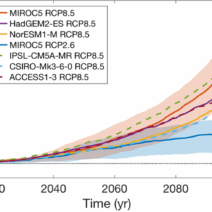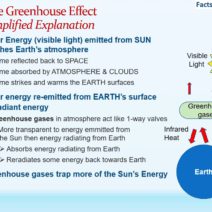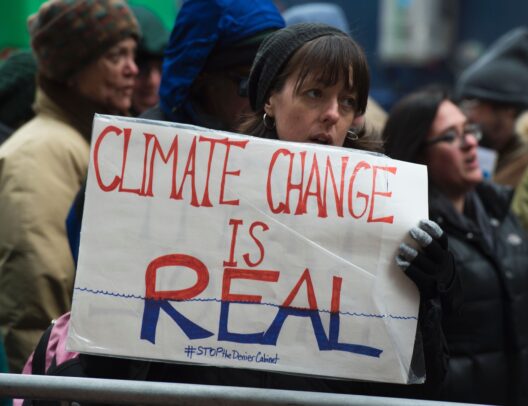In the intricate tapestry of our atmosphere, tropospheric ozone serves as a double-edged sword. This elusive gas, residing between the surface of the earth and approximately 10 to 12 kilometers up, plays a pivotal role not only in shielding our planet from the harsh rays of the sun but also in exacerbating climate change. To comprehend the duality of tropospheric ozone is to embark on a journey through layers of complexity that affect human health, ecosystems, and the planetary climate system.
Tropospheric ozone is often inaccurately vilified as merely a pollutant—an antagonist in the story of air quality. However, it is crucial to recognize its origins. The gas is predominantly formed through the photochemical reactions of nitrogen oxides (NOx) and volatile organic compounds (VOCs) in the presence of sunlight. Urban environments, teeming with vehicles and industrial activities, provide the ideal conditions for these reactions. This process is akin to a painter blending colors: the resulting hue—ozone—has both beauty and threat. From a distance, it may appear as a shimmering blue sky; up close, it represents a toxic atmosphere detrimental to respiratory health.
Moreover, the manipulation of natural processes by human activities has led to an increase in tropospheric ozone concentrations. This augmentation catalyzes a myriad of repercussions. Studies indicate a direct correlation between elevated levels of tropospheric ozone and increased incidences of respiratory diseases, such as asthma and chronic bronchitis. As if the atmosphere is enacting some cruel irony, those living in urban sprawl, the very heart of economic development, often bear the brunt of its effects. The disparity is as stark as the contrasting sides of a coin, where progress comes at a significant human cost.
Beyond immediate health implications, tropospheric ozone also acts as a significant greenhouse gas, albeit with nuances that many might overlook. Unlike carbon dioxide, which is ubiquitous and persistent, ozone is short-lived, with a typical atmospheric lifespan of only a few days to weeks. Yet in that ephemeral existence, it holds immense heat-trapping potential. According to various estimations, its global warming potential can be several times greater than that of carbon dioxide over a short time frame. In this sense, tropospheric ozone acts as a speeding freight train: while it may not have the longevity of its counterparts like CO2, its impact surges rapidly upon release.
As we delve deeper, it becomes increasingly clear that tropospheric ozone is both a product and a catalyst of climate change. Its formation is heavily influenced by meteorological conditions, such as heatwaves and stagnant air masses. Such conditions are becoming more frequent and intense due to global warming—a self-perpetuating cycle. For instance, hotter climates exacerbate the chemical reactions that form ozone while simultaneously increasing its deleterious impacts on plants. Crops adversely affected by high ozone levels exhibit reduced photosynthetic efficiency, leading to diminished agricultural yields. This, in turn, exacerbates food security issues in a world already grappling with population growth and resource scarcity.
Furthermore, the agricultural sector is not the only victim of ozone’s toxic embrace. Ecosystems and biodiversity also suffer. Forests, the lungs of our planet, are particularly vulnerable. Prolonged exposure to elevated tropospheric ozone levels can inhibit the growth of tree seedlings and reduce their resilience to disease and pests. It is a chain reaction where the fabric of life itself unravels in the face of air pollution, altering habitats and creating a cascade of ecological imbalances.
Understanding the intricacies of tropospheric ozone and its relationship with climate change is crucial for informed policy-making. Efforts to mitigate air pollution and reduce greenhouse gas emissions must address these two phenomena simultaneously. Governments around the world are beginning to recognize that effective climate solutions can also lead to improved air quality, thus enhancing public health outcomes. Incorporating stringent emissions standards for vehicles and promoting clean energy alternatives can converge as dual strategies to combat both ozone formation and climate change.
The link between tropospheric ozone and climate change invites a broader discourse on the interconnectedness of environmental issues. It serves as a reminder that in the grand scheme of ecological balance, elements often perceived as isolated from one another are, in fact, interwoven threads of a larger narrative. The complexity of atmospheric chemistry and its implications on health and ecosystems underscore the importance of an integrated approach—where policies are not crafted in silos but instead recognize the intricate interdependencies of various environmental factors.
Effective engagement with these issues involves not only policy initiatives but also public awareness. Education plays a critical role in empowering communities to understand the implications of their footprints. As individuals, advocating for cleaner transportation methods, participating in reforestation efforts, and demanding accountability from industries can translate to collective action. Such grassroots movements can begin to dismantle the entrenched systems that perpetuate pollution and climate destabilization.
Tropospheric ozone, often ensconced in the shadows of climate discourse, warrants our attention. As this gas encompasses the complex interplay of natural sciences and human activities, it reflects our shared responsibility for stewardship of the planet. The path forward hinges upon informed action—fostering a future where the air we breathe supports vitality and resilience for all. Through a concerted effort to address these intertwined issues, society can aspire to mend the delicate fabric of our atmosphere, ensuring a sustainable future for generations to come.





